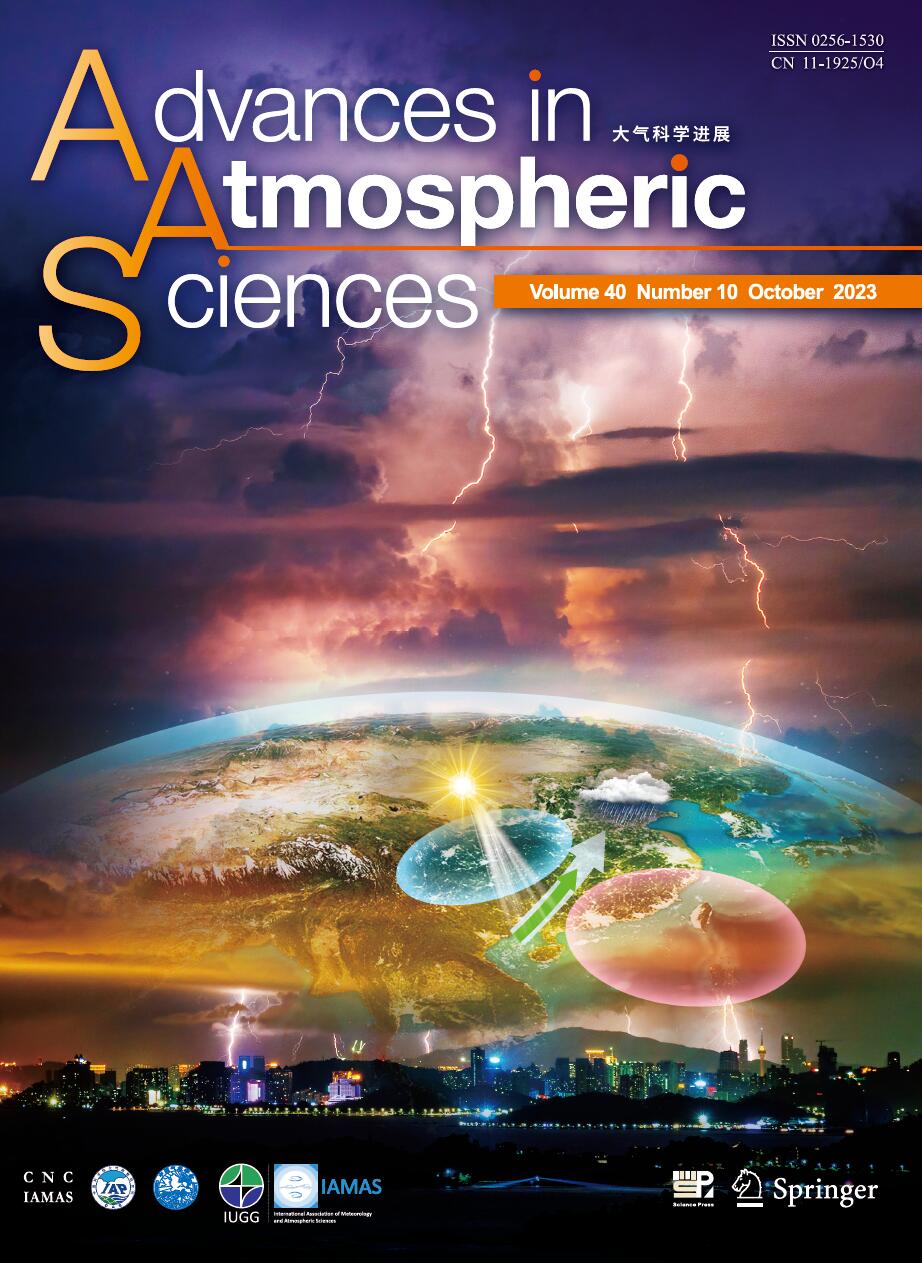| [1] |
LIU Zhengyu, WU Shu, ZHANG Shaoqing, LIU Yun, RONG Xinyao, ,
2013: Ensemble Data Assimilation in a Simple Coupled Climate Model: The Role of Ocean-Atmosphere Interaction, ADVANCES IN ATMOSPHERIC SCIENCES, 30, 1235-1248.
doi: 10.1007/s00376-013-2268-z
|
| [2] |
FU Weiwei, ZHOU Guangqing, WANG Huijun,
2006: Modeling the Tropical Pacific Ocean Using a Regional Coupled Climate Model, ADVANCES IN ATMOSPHERIC SCIENCES, 23, 625-638.
doi: 10.1007/s00376-006-0625-x
|
| [3] |
ZHENG Weipeng, YU Yongqiang,
2007: ENSO Phase-Locking in an Ocean-tmosphere Coupled Model FGCM-1.0, ADVANCES IN ATMOSPHERIC SCIENCES, 24, 833-844.
doi: 10.1007/s00376-007-0833-z
|
| [4] |
Yawen DUAN, Peili WU, Xiaolong CHEN, Zhuguo MA,
2018: Assessing Global Warming Induced Changes in Summer Rainfall Variability over Eastern China Using the Latest Hadley Centre Climate Model HadGEM3-GC2, ADVANCES IN ATMOSPHERIC SCIENCES, 35, 1077-1093.
doi: 10.1007/s00376-018-7264-x
|
| [5] |
KANG Xianbiao, HUANG Ronghui, WANG Zhanggui, ZHANG Rong-Hua,
2014: Sensitivity of ENSO Variability to Pacific Freshwater Flux Adjustment in the Community Earth System Model, ADVANCES IN ATMOSPHERIC SCIENCES, 31, 1009-1021.
doi: 10.1007/s00376-014-3232-2
|
| [6] |
Dai Yongjiu, Xue Feng, Zeng Qingcun,
1998: A Land Surface Model (IAP94) for Climate Studies Part II: Implementation and Preliminary Results of Coupled Model with IAP GCM, ADVANCES IN ATMOSPHERIC SCIENCES, 15, 47-62.
doi: 10.1007/s00376-998-0017-5
|
| [7] |
Se-Hwan YANG, LI Chaofan, and LU Riyu,
2014: Predictability of Winter Rainfall in South China as Demonstrated by the Coupled Models of ENSEMBLES, ADVANCES IN ATMOSPHERIC SCIENCES, 31, 779-786.
doi: 10.1007/s00376-013-3172-2
|
| [8] |
Yuyang GUO, Yongqiang YU, Pengfei LIN, Hailong LIU, Bian HE, Qing BAO, Shuwen ZHAO, Xiaowei WANG,
2020: Overview of the CMIP6 Historical Experiment Datasets with the Climate System Model CAS FGOALS-f3-L, ADVANCES IN ATMOSPHERIC SCIENCES, 37, 1057-1066.
doi: 10.1007/s00376-020-2004-4
|
| [9] |
WANG Zhiren, WU Dexing, CHEN Xue'en, QIAO Ran,
2013: ENSO Indices and Analyses, ADVANCES IN ATMOSPHERIC SCIENCES, 30, 1491-1506.
doi: 10.1007/s00376-012-2238-x
|
| [10] |
Zhou Tianjun, Yu Rucong, Li Zhaoxin,
2002: ENSO-Dependent and ENSO-Independent Variability over the Mid-Latitude North Pacific: Observation and Air-Sea Coupled Model Simulation, ADVANCES IN ATMOSPHERIC SCIENCES, 19, 1127-1147.
doi: 10.1007/s00376-002-0070-4
|
| [11] |
Xinyi XING, Xianghui FANG, Da PANG, Chaopeng JI,
2024: Seasonal Variation of the Sea Surface Temperature Growth Rate of ENSO, ADVANCES IN ATMOSPHERIC SCIENCES, 41, 465-477.
doi: 10.1007/s00376-023-3005-x
|
| [12] |
Bin MU, Juhui REN, Shijin YUAN, Rong-Hua ZHANG, Lei CHEN, Chuan GAO,
2019: The Optimal Precursors for ENSO Events Depicted Using the Gradient-definition-based Method in an Intermediate Coupled Model, ADVANCES IN ATMOSPHERIC SCIENCES, 36, 1381-1392.
doi: 10.1007/s00376-019-9040-y
|
| [13] |
ZHENG Fei, ZHU Jiang, Rong-Hua ZHANG, ZHOU Guangqing,
2006: Improved ENSO Forecasts by Assimilating Sea Surface Temperature Observations into an Intermediate Coupled Model, ADVANCES IN ATMOSPHERIC SCIENCES, 23, 615-624.
doi: 10.1007/s00376-006-0615-z
|
| [14] |
LI Gang*, LI Chongyin, TAN Yanke, and BAI Tao,
2014: The Interdecadal Changes of South Pacific Sea Surface Temperature in the Mid-1990s and Their Connections with ENSO, ADVANCES IN ATMOSPHERIC SCIENCES, 31, 66-84.
doi: 10.1007/s00376-013-2280-3
|
| [15] |
Xiaofei WU, Jiangyu MAO,
2019: Decadal Changes in Interannual Dependence of the Bay of Bengal Summer Monsoon Onset on ENSO Modulated by the Pacific Decadal Oscillation, ADVANCES IN ATMOSPHERIC SCIENCES, 36, 1404-1416.
doi: 10.1007/s00376-019-9043-8
|
| [16] |
Yuanhai FU, Zhongda LIN, Tao WANG,
2021: Simulated Relationship between Wintertime ENSO and East Asian Summer Rainfall: From CMIP3 to CMIP6, ADVANCES IN ATMOSPHERIC SCIENCES, 38, 221-236.
doi: 10.1007/s00376-020-0147-y
|
| [17] |
Yadi LI, Xichen LI, Juan FENG, Yi ZHOU, Wenzhu WANG, Yurong HOU,
2024: Uncertainties of ENSO-related Regional Hadley Circulation Anomalies within Eight Reanalysis Datasets, ADVANCES IN ATMOSPHERIC SCIENCES, 41, 115-140.
doi: 10.1007/s00376-023-3047-0
|
| [18] |
Jingrui YAN, Wenjun ZHANG, Suqiong HU, Feng JIANG,
2024: Different ENSO Impacts on Eastern China Precipitation Patterns in Early and Late Winter Associated with Seasonally-Varying Kuroshio Anticyclonic Anomalies, ADVANCES IN ATMOSPHERIC SCIENCES.
doi: 10.1007/s00376-023-3196-1
|
| [19] |
Shang-Ping XIE, Yu KOSAKA, Yan DU, Kaiming HU, Jasti S. CHOWDARY, Gang HUANG,
2016: Indo-Western Pacific Ocean Capacitor and Coherent Climate Anomalies in Post-ENSO Summer: A Review, ADVANCES IN ATMOSPHERIC SCIENCES, 33, 411-432.
doi: 10.1007/s00376-015-5192-6
|
| [20] |
XU Tengfei, YUAN Dongliang, YU Yongqiang, and ZHAO Xia,
2013: An assessment of Indo-Pacific oceanic channel dynamics in the FGOALS-g2 coupled climate system model, ADVANCES IN ATMOSPHERIC SCIENCES, 30, 997-1016.
doi: 10.1007/s00376-013-2131-2
|















 AAS Website
AAS Website 
 AAS WeChat
AAS WeChat 
 DownLoad:
DownLoad: